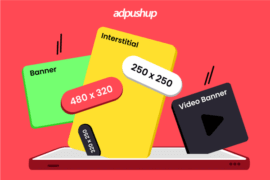In-app advertising, also referred to as mobile app advertising, is a giant leap by brands and publishers to generate maximum revenue.
According to Statista, approximately $318 billion US dollars was generated through in-app advertising. Furthermore, it is estimated to reach a staggering USD 613 billion by 2025.
In-app advertising is an important and effective marketing channel which provides the most engaging user experience without interrupting app engagement.
Calculating in-app advertising rates:
Calculating in-app advertising rates can be tricky. It takes various factors into account, such as:
- Ad space
- Goal of advertising
- Ad format
- Target audience
- App’s demographics
- Type of device and operating system
How does in-app advertising work?
Various players are at play within the ecosystem of in-app advertising, such as app developers, ad exchanges, publishers, ad networks, and Demand Side and Supply Side Platforms.
The app developers/publishers buy the ads. In contrast, publishers sell ad space. In the middle is the ad network, which facilitates the buying and selling of ad space to advertisers.
1. Choosing the target audience:
Advertisers or marketers choose the target audience based on age, demographics or preferences.
For example, a brand selling sports equipment can decide to target a male audience between 18 and 25 years of age in India.
2. Deciding the goal for in-app advertising:
The next step involves determining the goal of in-app advertising. The purpose of advertising can be:
- Brand awareness
- Generating in-app advertising revenue
- Calling for a specific action – to download or install the application
It also includes marketers deciding how much to spend on ad campaigns.
3. Best-suited in-app ad format:
Establishing the type of ad format that accommodates the best user experience is important. For example, choosing banner ads can be unobtrusive but generate low revenue than video ads. Therefore, choosing the format that engages the user is vital.
4. Reviewing the ad campaign:
For in-app advertising to be successful, the selected ad campaign enters the ad network’s management system. There, the ad ops review the ad campaign to ensure quality standards and protocols adhered to. Upon getting the green signal, the ad network queues the ad.
5. Serving of ad:
Finally, the application launch triggers the ad network’s Software Development Kit (SDK) or API (Application Programming Interface). This tells that the user is ready to be served with the ad.
To be noted:
- SDK’s data ensures that the ad network serves the relevant ad for maximising in-app advertising revenue.
- Users can choose not to engage with the ad, leave it in the middle, or not take the desired action.
6. Payout time:
Payout in in-app advertising depends on how well the ad campaign has performed. Ad networks and third parties analyse the ad campaign’s performance.
How to calculate in-app advertising rates through various pricing models?
Different pricing models determine the best performance for generating revenue from in-app advertising. First, let us understand the most widely used models:
1. Cost per mille (CPM)
Mille is Latin for thousand. Thus, cost per mille refers to the cost paid by the advertisers to show 1000 impressions of the ad. It is the most commonly used model to generate in-app advertising revenue. It can be calculated as:
CPM = (TOTAL COST / NO. OF IMPRESSIONS) * 1000
Total is the expenditure on ad campaigns by the advertisers.
For example, if the advertiser has spent 100$ on an ad campaign and received 50,000 impressions, the cost per thousand will be $2.
2. Cost per click (CPC):
Pay-per-click means advertisers only pay when the users click or interact with their ad. It refers to the average total cost by the number of clicks.
For advertisers, it is a cost-effective model since advertisers pay nothing for ads that do not get clicked. For publishers, on the contrary, it is a demerit as they give away free impressions without generating revenue from it.
It can be calculated as:
CPC= Total Cost/ Number of Clicks
For example, if an ad costing $2 and the other is $1 clicked,
then CPC will be: $(2+1)/2 = $1.5
3. Cost per action (CPA):
Another model that determines in-app advertising rates is the cost per action. It refers to paying the publisher only when the click leads to certain actions, such as installing, downloading, or subscribing to the newsletter.
This model is a safe option for advertisers since they only pay after the conversion.
It can be calculated as:
CPA= Total Cost/ No. of Acquisitions
Although the pricing model for generating in-app advertising revenue depends on the needs of advertisers and publishers, CPM is the most predictable model.
How much does in-app adverting pay?
Various factors determine how much advertisers pay for in-app advertising:
The type of ad format used:
In contrast to the average CTR OF 0.6% for banner ads, video ads register more growth with a 300% higher CPM.
Operating system used:
Advertisers usually shell out more to reach a specific target audience. Since IOS users are rich than android users, it is evident that advertisers are more willing to pay 30% more to reach users who use iPhone operating system.
Device type:
Another determining factor is the device type. Some advertisers or brands may decide on the ads’ price on certain devices. It is possible that advertisers may pay to show their ads specifically on the latest smartphones rather than on tablets or i-pads. To cite an example, SAMSUNG specifically led the ad campaign targeting those using old phones to compel them to upgrade.
Demographically dependent in-app advertising:
How much advertisers pay for in-app advertising also depends on the geographical location of the users. Some advertisers may be willing to pay more to target the audience with rich zip codes. For example, by analysing the SDK data of the user, sports enthusiasts may be served with ads relating to nearby sports equipment shops.
Time of the year or day:
People usually launch apps or open their devices at certain times. Some advertisers pay to get their ads displayed at certain times of the day or during specific occasions such as Christmas or black Friday. At these times of day or years, better CPMs, and CTRs are guaranteed.
Average CPM rates:
As per websites:
- Media.net: publishers are likely to get $1 to $1.25 CPM
- Criteo: with better CPM, it is between $1 to $4 in case of tier 1 traffic.
- Propellerads: it offers publishers CPM of $0.50 to $1.
- Adblade network: this network has an average CPM of $2.
CPM rates in India:
- Video ad CPM rates account for $5 to $7 in India.
- Banner ads cost up to $0.50 to $1.
CPM rates in the USA:
- For video ads, the CPM is $5 to $30.
- Banner ads account for $12 to $15.
Final words
With 66.6% global population using mobile devices, mobile advertising spending is expected to exceed $339 billion by 2023. The rising statistics give publishers, brands and marketers unlock the full potential of in-app advertising to generate revenue and get their brands recognised.
FAQs
Best Practices for In-App Advertising Success
1. Try Interstitial Ads
2. Know Where Your Ads Go
3. Select Right Ad Banners for Reach
4. Use Interactive Video Ads to Increase Engagement
5. Try Rewarded Video Ads to Gain High-Quality Conversions
6. Choose Supply Partners Wisely

Shubham is a digital marketer with rich experience working in the advertisement technology industry. He has vast experience in the programmatic industry, driving business strategy and scaling functions including but not limited to growth and marketing, Operations, process optimization, and Sales.






